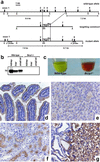The breast cancer resistance protein protects against a major chlorophyll-derived dietary phototoxin and protoporphyria
- PMID: 12429862
- PMCID: PMC137771
- DOI: 10.1073/pnas.202607599
The breast cancer resistance protein protects against a major chlorophyll-derived dietary phototoxin and protoporphyria
Abstract
The breast cancer resistance protein (BCRPABCG2) is a member of the ATP-binding cassette family of drug transporters and confers resistance to various anticancer drugs. We show here that mice lacking Bcrp1Abcg2 become extremely sensitive to the dietary chlorophyll-breakdown product pheophorbide a, resulting in severe, sometimes lethal phototoxic lesions on light-exposed skin. Pheophorbide a occurs in various plant-derived foods and food supplements. Bcrp1 transports pheophorbide a and is highly efficient in limiting its uptake from ingested food. Bcrp1(-/-) mice also displayed a previously unknown type of protoporphyria. Erythrocyte levels of the heme precursor and phototoxin protoporphyrin IX, which is structurally related to pheophorbide a, were increased 10-fold. Transplantation with wild-type bone marrow cured the protoporphyria and reduced the phototoxin sensitivity of Bcrp1(-/-) mice. These results indicate that humans or animals with low or absent BCRP activity may be at increased risk for developing protoporphyria and diet-dependent phototoxicity and provide a striking illustration of the importance of drug transporters in protection from toxicity of normal food constituents.
Figures




Similar articles
-
P-glycoprotein and breast cancer resistance protein: two dominant transporters working together in limiting the brain penetration of topotecan.Clin Cancer Res. 2007 Nov 1;13(21):6440-9. doi: 10.1158/1078-0432.CCR-07-1335. Clin Cancer Res. 2007. PMID: 17975156
-
The breast cancer resistance protein (Bcrp1/Abcg2) restricts exposure to the dietary carcinogen 2-amino-1-methyl-6-phenylimidazo[4,5-b]pyridine.Cancer Res. 2003 Oct 1;63(19):6447-52. Cancer Res. 2003. PMID: 14559835
-
In vitro evaluation of photosensitivity risk related to genetic polymorphisms of human ABC transporter ABCG2 and inhibition by drugs.Drug Metab Pharmacokinet. 2007 Dec;22(6):428-40. doi: 10.2133/dmpk.22.428. Drug Metab Pharmacokinet. 2007. PMID: 18159130
-
Drug-induced phototoxicity evoked by inhibition of human ABC transporter ABCG2: development of in vitro high-speed screening systems.Expert Opin Drug Metab Toxicol. 2008 Mar;4(3):255-72. doi: 10.1517/17425255.4.3.255. Expert Opin Drug Metab Toxicol. 2008. PMID: 18363541 Review.
-
ABCG2 (BCRP) expression in normal and malignant hematopoietic cells.Hematol Oncol. 2003 Sep;21(3):115-30. doi: 10.1002/hon.714. Hematol Oncol. 2003. PMID: 14579240 Review.
Cited by
-
ABCG2 Gene Expression in Non-Small Cell Lung Cancer.Biomedicines. 2024 Oct 19;12(10):2394. doi: 10.3390/biomedicines12102394. Biomedicines. 2024. PMID: 39457707 Free PMC article.
-
Biological Assay-Guided Fractionation and Mass Spectrometry-Based Metabolite Profiling of Annona muricata L. Cytotoxic Compounds against Lung Cancer A549 Cell Line.Plants (Basel). 2022 Sep 12;11(18):2380. doi: 10.3390/plants11182380. Plants (Basel). 2022. PMID: 36145779 Free PMC article.
-
Hepatic and renal Bcrp transporter expression in mice treated with perfluorooctanoic acid.Toxicology. 2013 Apr 5;306:108-13. doi: 10.1016/j.tox.2013.02.009. Epub 2013 Feb 19. Toxicology. 2013. PMID: 23435180 Free PMC article.
-
Evaluation of limiting brain penetration related to P-glycoprotein and breast cancer resistance protein using [(11)C]GF120918 by PET in mice.Mol Imaging Biol. 2011 Feb;13(1):152-60. doi: 10.1007/s11307-010-0313-1. Mol Imaging Biol. 2011. PMID: 20379788
-
An update on expression and function of P-gp/ABCB1 and BCRP/ABCG2 in the placenta and fetus.Expert Opin Drug Metab Toxicol. 2018 Aug;14(8):817-829. doi: 10.1080/17425255.2018.1499726. Epub 2018 Aug 3. Expert Opin Drug Metab Toxicol. 2018. PMID: 30010462 Free PMC article. Review.
References
-
- Borst P. & Oude Elferink, R. (2002) Annu. Rev. Biochem. 71 537-592. - PubMed
-
- Allen J. D. & Schinkel, A. H. (2002) Mol. Cancer Ther. 1 427-434. - PubMed
-
- Jonker J. W., Smit, J. W., Brinkhuis, R. F., Maliepaard, M., Beijnen, J. H., Schellens, J. H. & Schinkel, A. H. (2000) J. Natl. Cancer Inst. 92 1651-1656. - PubMed
-
- Kruijtzer C. M., Beijnen, J. H., Rosing, H., ten Bokkel Huinink, W. W., Schot, M., Jewell, R. C., Paul, E. M. & Schellens, J. H. (2002) J. Clin. Oncol. 20 2943-2950. - PubMed
Publication types
MeSH terms
Substances
LinkOut - more resources
Full Text Sources
Other Literature Sources
Molecular Biology Databases

